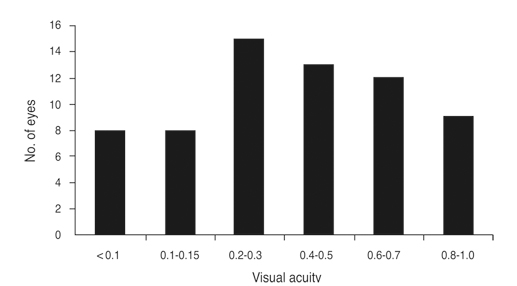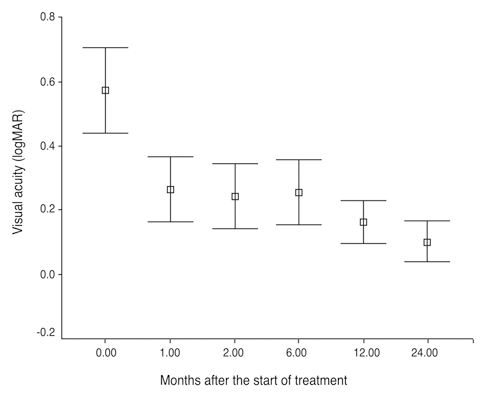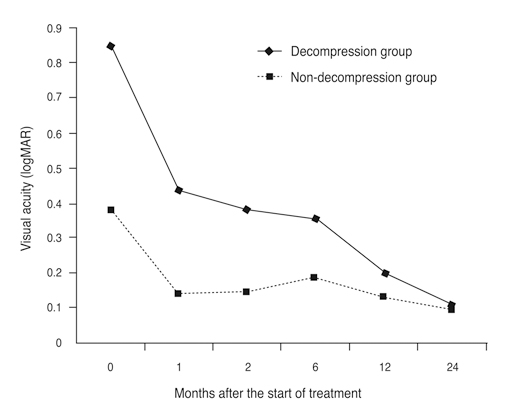Korean J Ophthalmol.
2012 Apr;26(2):73-79. 10.3341/kjo.2012.26.2.73.
Clinical Profile and Visual Outcomes after Treatment in Patients with Dysthyroid Optic Neuropathy
- Affiliations
-
- 1Seoul Eye Clinic, Hampyeong, Korea.
- 2Department of Ophthalmology, Kangdong Kyung Hee Medical Center, Kyung Hee University College of Medicine, Seoul, Korea.
- 3Department of Ophthalmology, Samsung Medical Center, Sungkyunkwan University School of Medicine, Seoul, Korea. ydkimoph@skku.edu
- KMID: 1364858
- DOI: http://doi.org/10.3341/kjo.2012.26.2.73
Abstract
- PURPOSE
To report the clinical data and visual outcomes after treatment of patients with dysthyroid optic neuropathy (DON).
METHODS
We retrospectively reviewed the medical records and orbital images of 40 patients (65 eyes) with DON and analyzed the visual outcomes after treatment with intravenous steroids pulse therapy, radiotherapy and orbital decompression.
RESULTS
The study included 21 men and 19 women, with 10 (25%) being diabetic patients. Visual field test results revealed defects in 88.7% of DON eyes; afferent pupillary defects in 63.2%; reduced color vision in 78.5%; and abnormal visual evoked potentials in 84%. Orbital imaging showed moderate to severe apical crowding in 95% of the orbits and intracranial fat prolapse in 24.2%. Median best corrected visual acuity improved from 0.4 to 1.0 after one year of treatment (p < 0.001). We noted more improvement in vision with the use of decompressive surgery than with non-surgical methods (p < 0.05). Recurrences occurred in 7 patients who had not received orbital radiotherapy.
CONCLUSIONS
Visual field defects and apical crowding seen on orbital imaging were the most sensitive indicators for the detection of DON. Treatment with intravenous steroids pulse therapy, radiotherapy and orbital decompression effectively improved visual outcomes in cases of DON.
MeSH Terms
-
Adult
Aged
Combined Modality Therapy
*Decompression, Surgical
Diabetes Complications
Evoked Potentials, Visual
Female
*Graves Ophthalmopathy/pathology/surgery/therapy
Humans
Male
Middle Aged
Pulse Therapy, Drug
Pupil Disorders
*Radiotherapy
Recovery of Function
Recurrence/prevention & control
Retrospective Studies
Steroids/*administration & dosage
Visual Acuity
Visual Fields
Young Adult
Figure
Reference
-
1. Lucarelli MJ, Shore JW. Management of thyroid optic neuropathy. Int Ophthalmol Clin. 1996. 36:179–193.2. Rootman J. Diseases of the orbit: a multidisciplinary approach. 2003. 2nd ed. Philadelphia: Lippincott Williams & Wilkins;182–196.3. Neigel JM, Rootman J, Belkin RI, et al. Dysthyroid optic neuropathy: the crowded orbital apex syndrome. Ophthalmology. 1988. 95:1515–1521.4. Soares-Welch CV, Fatourechi V, Bartley GB, et al. Optic neuropathy of Graves disease: results of transantral orbital decompression and long-term follow-up in 215 patients. Am J Ophthalmol. 2003. 136:433–441.5. Trobe JD, Glaser JS, Laflamme P. Dysthyroid optic neuropathy: clinical profile and rationale for management. Arch Ophthalmol. 1978. 96:1199–1209.6. Kennerdell JS, Rosenbaum AE, El-Hoshy MH. Apical optic nerve compression of dysthyroid optic neuropathy on computed tomography. Arch Ophthalmol. 1981. 99:807–809.7. Giaconi JA, Kazim M, Rho T, Pfaff C. CT scan evidence of dysthyroid optic neuropathy. Ophthal Plast Reconstr Surg. 2002. 18:177–182.8. Day RM, Carroll FD. Optic nerve involvement associated with thyroid dysfunction. Arch Ophthalmol. 1962. 67:289–297.9. Chang EL, Bernardino CR, Rubin PA. Transcaruncular orbital decompression for management of compressive optic neuropathy in thyroid-related orbitopathy. Plast Reconstr Surg. 2003. 112:739–747.10. Kazim M, Goldberg RA, Smith TJ. Insights into the pathogenesis of thyroid-associated orbitopathy: evolving rationale for therapy. Arch Ophthalmol. 2002. 120:380–386.11. Hedges TR Jr, Scheie HG. Visual field defects in exophthalmos associated with thyroid disease. AMA Arch Ophthalmol. 1955. 54:885–892.12. Henderson JW. Optic neuropathy of exophthalmic goiter (Graves' disease). AMA Arch Ophthalmol. 1958. 59:471–480.13. Guy JR, Fagien S, Donovan JP, Rubin ML. Methylprednisolone pulse therapy in severe dysthyroid optic neuropathy. Ophthalmology. 1989. 96:1048–1052.14. Marcocci C, Bartalena L, Tanda ML, et al. Comparison of the effectiveness and tolerability of intravenous or oral glucocorticoids associated with orbital radiotherapy in the management of severe Graves' ophthalmopathy: results of a prospective, single-blind, randomized study. J Clin Endocrinol Metab. 2001. 86:3562–3567.15. Kazim M, Trokel S, Moore S. Treatment of acute Graves orbitopathy. Ophthalmology. 1991. 98:1443–1448.16. Hurbli T, Char DH, Harris J, et al. Radiation therapy for thyroid eye diseases. Am J Ophthalmol. 1985. 99:633–637.17. Mourits MP, van Kempen-Harteveld ML, Garcia MB, et al. Radiotherapy for Graves' orbitopathy: randomised placebo-controlled study. Lancet. 2000. 355:1505–1509.18. Gorman CA, Garrity JA, Fatourechi V, et al. A prospective, randomized, double-blind, placebo-controlled study of orbital radiotherapy for Graves' ophthalmopathy. Ophthalmology. 2001. 108:1523–1534.19. Boulos PR, Hardy I. Thyroid-associated orbitopathy: a clinicopathologic and therapeutic review. Curr Opin Ophthalmol. 2004. 15:389–400.20. McKeag D, Lane C, Lazarus JH, et al. Clinical features of dysthyroid optic neuropathy: a European Group on Graves' Orbitopathy (EUGOGO) survey. Br J Ophthalmol. 2007. 91:455–458.21. Nugent RA, Belkin RI, Neigel JM, et al. Graves orbitopathy: correlation of CT and clinical findings. Radiology. 1990. 177:675–682.22. Barrett L, Glatt HJ, Burde RM, Gado MH. Optic nerve dysfunction in thyroid eye disease: CT. Radiology. 1988. 167:503–507.23. Birchall D, Goodall KL, Noble JL, Jackson A. Graves ophthalmopathy: intracranial fat prolapse on CT images as an indicator of optic nerve compression. Radiology. 1996. 200:123–127.24. Durairaj VD, Bartley GB, Garrity JA. Clinical features and treatment of graves ophthalmopathy in pediatric patients. Ophthal Plast Reconstr Surg. 2006. 22:7–12.25. Young LA. Dysthyroid ophthalmopathy in children. J Pediatr Ophthalmol Strabismus. 1979. 16:105–107.26. Uretsky SH, Kennerdell JS, Gutai JP. Graves' ophthalmopathy in childhood and adolescence. Arch Ophthalmol. 1980. 98:1963–1964.27. Kalmann R, Mourits MP. Diabetes mellitus: a risk factor in patients with Graves' orbitopathy. Br J Ophthalmol. 1999. 83:463–465.28. Day RM, Carroll FD. Corticosteroids in the treatment of optic nerve involvement associated with thyroid dysfunction. Trans Am Ophthalmol Soc. 1967. 65:41–51.29. Anderson RL, Tweeten JP, Patrinely JR, et al. Dysthyroid optic neuropathy without extraocular muscle involvement. Ophthalmic Surg. 1989. 20:568–574.30. Mourits M, Kalmann R, Sasim IV. Methylprednisolone pulse therapy for patients with dysthyroid optic neuropathy. Orbit. 2001. 20:275–280.31. Bartalena L, Marcocci C, Chiovato L, et al. Orbital cobalt irradiation combined with systemic corticosteroids for Graves' ophthalmopathy: comparison with systemic corticosteroids alone. J Clin Endocrinol Metab. 1983. 56:1139–1144.32. Marcocci C, Bartalena L, Bogazzi F, et al. Orbital radiotherapy combined with high dose systemic glucocorticoids for Graves' ophthalmopathy is more effective than radiotherapy alone: results of a prospective randomized study. J Endocrinol Invest. 1991. 14:853–860.33. Carter KD, Frueh BR, Hessburg TP, Musch DC. Long-term efficacy of orbital decompression for compressive optic neuropathy of Graves eye disease. Ophthalmology. 1991. 98:1435–1442.34. Liao SL, Chang TC, Lin LL. Transcaruncular orbital decompression: an alternate procedure for Graves ophthalmopathy with compressive optic neuropathy. Am J Ophthalmol. 2006. 141:810–818.
- Full Text Links
- Actions
-
Cited
- CITED
-
- Close
- Share
- Similar articles
-
- Endoscopic Orbital Decompression for Dysthyroid Optic Neuropathy
- The Etiology of Optic Neuropathy
- Three Cases of Endoscopic Endonasal Optic Nerve Decompression for Nontraumatic Optic Neuropathy
- Clinical Evaluation of the Traumatic Optic Neuropathy
- The Effect of Corticosteroid in Traumatic Optic Neuropathy




